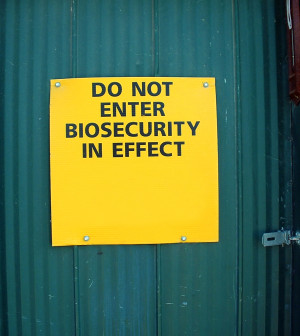- Skip Storing This Everyday Product in the Fridge Door
- Green Tea + B3 Pairing May Boost Brain Health
- Navigating Your Midlife Crisis: Embracing New Possibilities
- City Raccoons Showing Signs of Domestication
- Mapping the Exposome: Science Broadens Focus to Environmental Disease Triggers
- One Week Less on Social Media Linked to Better Mental Health
- Your Brain Changes in Stages as You Age, Study Finds
- Some Suicide Victims Show No Typical Warning Signs, Study Finds
- ByHeart Formula Faces Lawsuits After Babies Sickened With Botulism
- Switch to Vegan Diet Could Cut Your Greenhouse Gas Emissions in Half
Fast Action Can Prevent Sepsis Death: CDC

Many cases of life-threatening sepsis could be recognized and treated long before it causes severe illness or death, U.S. health officials report.
Sepsis, or septicemia, occurs when the body has an extreme response to an infection. Without prompt treatment, organ failure can quickly follow.
Researchers from the U.S. Centers for Disease Control and Prevention found that about 70 percent of patients with sepsis had used health care services recently or had chronic diseases that required regular medical care.
That means there are many opportunities for health care providers to intercept sepsis along its potentially deadly course, according to the CDC report.
“When sepsis occurs, it should be treated as a medical emergency,” CDC Director Dr. Tom Frieden said in an agency news release. “Doctors and nurses can prevent sepsis and also the devastating effects of sepsis, and patients and families can watch for sepsis and ask, ‘Could this be sepsis?'”
Infections of the lung, urinary tract, skin and gut most often lead to sepsis. In most cases, the germ that caused the sepsis-triggering infection can’t be identified. But when they are identified, the most common culprits are Staphylococcus aureus, Escherichia coli (E. coli), and some types of Streptococcus, the report said.
Patients with infections who are most likely to develop sepsis are aged 65 and older, less than 1 year old, people with weakened immune systems and those with chronic medical conditions such as diabetes.
But even healthy children and adults can develop sepsis from an infection, the CDC said in its Aug. 23 Vital Signs report.
Signs and symptoms of sepsis include: shivering, fever, or feeling very cold; extreme pain or discomfort; clammy or sweaty skin; confusion or disorientation; shortness of breath and a high heart rate.
Health care providers play a critical role in preventing sepsis. This includes following infection control measures such as hand washing and by ensuring patients get recommended vaccines, the CDC said.
It’s also essential to educate patients and their families about the need to prevent infections, manage chronic health conditions and seek immediate medical care if an infection doesn’t improve.
The CDC had additional advice for health care providers: Know the signs and symptoms of sepsis. If sepsis is suspected, order tests to determine if an infection is present, where it is and what caused it. Start antibiotics and other recommended medical care immediately.
Also, monitor patients closely and reassess antibiotic treatment within 24 to 48 hours or sooner to determine whether the type of antibiotics, dose and duration are correct, or need to be changed.
More information
The U.S. National Institute of General Medical Sciences has more on sepsis.
Source: HealthDay
Copyright © 2025 HealthDay. All rights reserved.










